Pink Birds in Florida
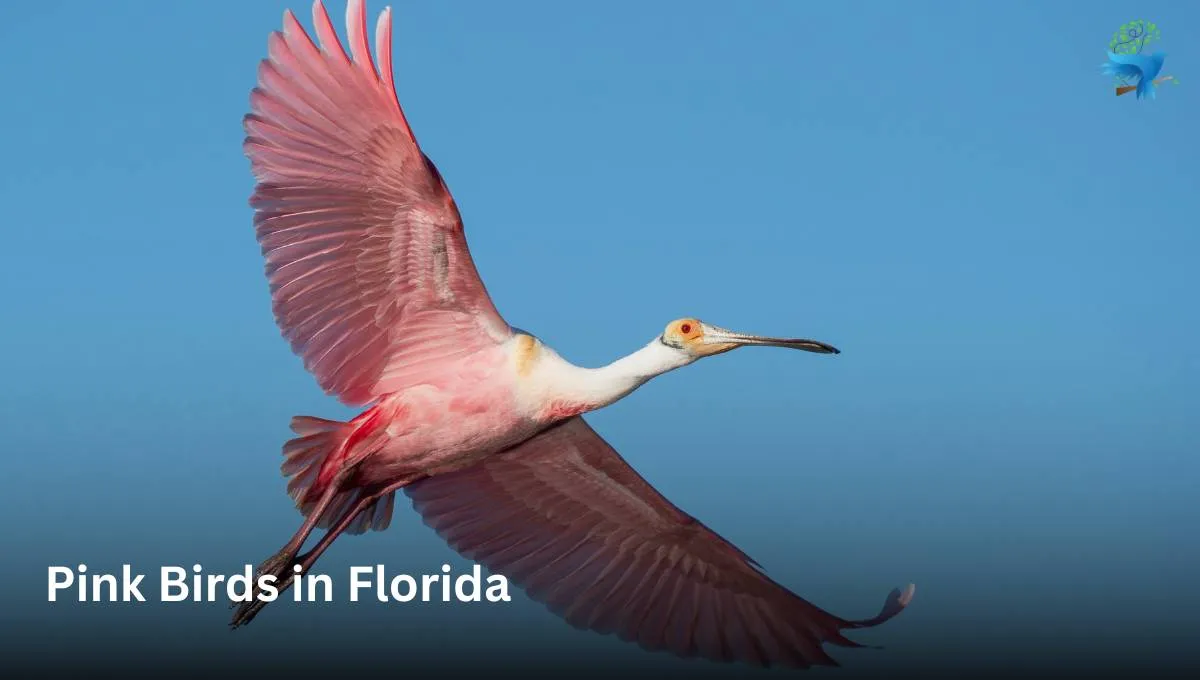
Florida is a state that lies in the southeastern region of the United States. There are a limited number of pink avian birds that are found in the state of Florida. Among them, the Roseate Spoonbill stands out as one of the largest wading birds that are spotted in Florida state.
Florida is a home for birds that serves as a haven for a diverse range of these mesmerizing pink-hued beauties. According to the Florida Ornithological Society Records Committee (FOSRC), there have been more than 539 species of birds that are included in the state of Florida.
In this blog post, we will be embarking on an exploration of the top seven fascinating pink birds that are found in the state of Florida. So, let us go through this article to know the birds’ names, their physical appearance, habitat, and their diet in detail.
List of 7 Pink Birds in Florida
- Roseate Tern
- American Flamingo
- Common Ground Dove
- Roseate Spoonbill
- Mourning Dove
- House Finch
- Scarlet Ibis
1. Roseate Tern (Sterna dougallii)
The roseate tern is a small bird that belongs to the family of Lardidae. The unique name of this bird, roseate refers to the pink breast of the birds in breeding plumage.
During the breeding season, they develop a sharp pointed thin bill that is black with a red base. The underparts of this tern are white, the upper wing pale grey, and very pale at the time of flight.
This bird indicates a pink coloration in their body which appears on them due to a major component, astaxanthin.

Size and Wingspan of Roseate Tern:
- Size: 13–14 inches (33–36 cm)
- Wingspan: 26 to 30 inches (67–76 cm)
Habitat: Typically, the roseate tern bird breeds in colonies on the islands and coasts. They forage in small flocks near estuaries, mudflats, and beaches.
It is also found from the south i.e. Nova Scotia to the Florida Keys, Cuba, Western Europe, and across the Caribbean Islands.
Feeding: The tern reflects some kleptoparasitic behavior. The roseate tern feeds on small marine fish and some invertebrates.
2. American Flamingo (Phoenicopterus ruber)
Commonly, the American flamingo bird is also known as the Caribbean flamingo. It is a large species of flamingo bird with reddish-pink plumage.
It has a white and pink long bill with a black tip. They also have a pink leg, the wings are red and the feathers are black. The name of this bird is quite similar to the rosy flamingo bird.
The lifespan of the American flamingo bird is 40 years. This results in one of the longest life expectancy in birds.
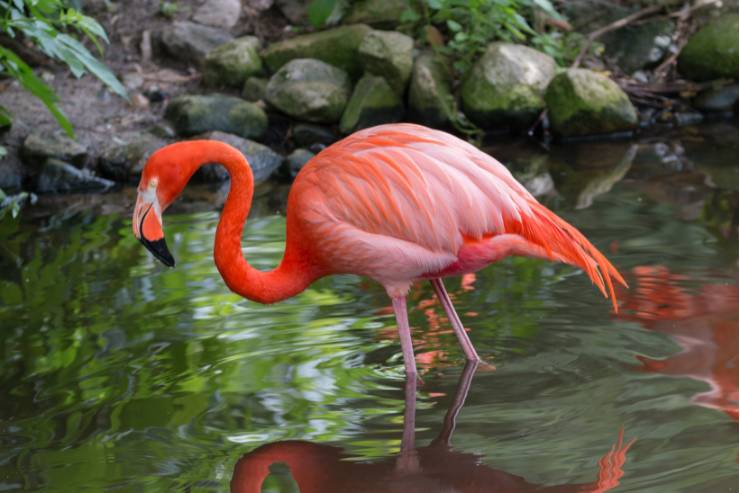
Size and Weight of American Flamingo:
- Size: 47 to 57 inches (120 to 145 cm)
- Weight of male: 6.2 lbs (2.8 kg)
- Weight of female: 4.9 lbs (2.2 kg)
Habitat: The American flamingo’s scientific name is Phoenicopterus ruber. In the state of Florida, this lovely bird is recognized as an iconic symbol in the United States.
These species of bird habitat in flocks in brackish water bodies, shallow waters, and as well as in alkaline lakes. These breeding birds are found in the Bahamas, West Indies, Venezuela, Colombia, Central America, Cuba, and North America.
Feeding: The American flamingo diet mostly depends upon the exact morphology of their beaks. They eat mollusks, nematodes, larvae, insects, small crustaceans, widgeon grass, algae, and some worms.
3. Common Ground Dove (Columbina passerina)
Common ground dove is recognized as one of the smallest dove in North America. Being a small bird, it belongs to the family of Columbidae.
Overall, these brilliant bird is identified with a soft whoops which increases their pitch sound. In terms of appearance, the common ground dove has pink color feathers that are surrounded near the bill.
It has a yellow bill with a black tip and the plumage of the bird’s back is brown. They display the same sexual dimorphism.
The adult males have slate-gray feathers on the top of their heads while the females have dull color.
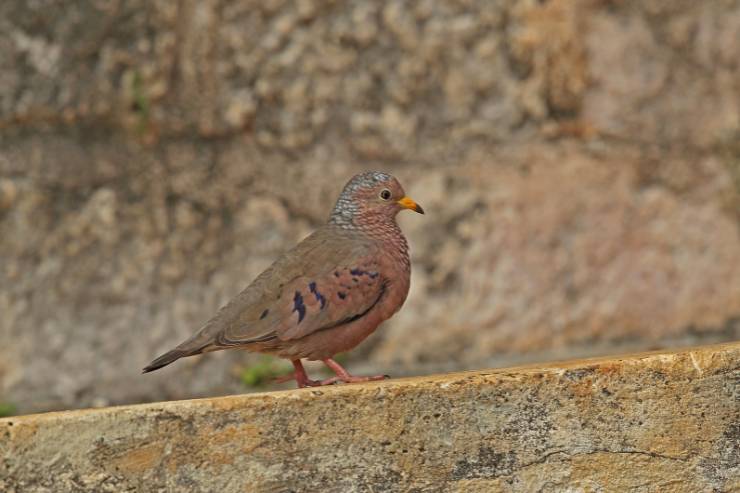
Size, Weight, and Wingspan of Common Ground Dove:
- Size: 5.9–7.1 inches (15–18 cm)
- Weight: 0.92–1.41 oz (26–40 g)
- Wingspan: 11 inches (27 cm)
Habitat: The breeding habitats are found in semi-open areas that have low bushes and grass. It is often seen in farmlands, savannahs, and sandy areas.
Generally, they reside in most parts of Mexico, the Caribbean islands, and across the southern United States (from California to Florida).
Feeding: This bird feeds on seeds, vegetation, fruits, insects, and snails. It is a ground gleaner bird that forages on the ground.
4. Roseate Spoonbill (Platalea ajaja)
The roseate spoonbill, a gregarious wading bird symbolizes the power and strength of stillness, self-knowing, and sensitivity.
It is a bird belonging to the family of Threskiornithidae that has long elongated grey bills. The adults have a white neck with a bare greenish head. The pink coloration appears in this bird because of the food they eat.
The roseate spoonbill’s breast and back are filled with a tuft of pink feathers in the center. The average life span of this bird is ten years.
However, the oldest roseate spoonbill recorded a life span of about 18 years which ranges from Argentina to Florida.
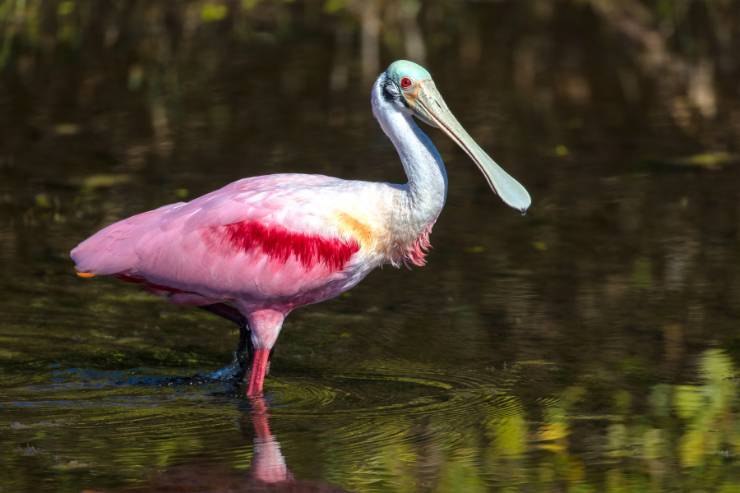
Size, Weight, and Wingspan of Roseate Spoonbill:
- Size: 28–34 inches (71–86 cm)
- Weight: 2.6–4.0 lbs (1.2–1.8 kg)
- Wingspan: 47–52 inches (120–133 cm)
Habitat: Commonly, the roseate spoonbill bird is a bird that is a resident breeder in North and South America. Widely, these birds are distributed everywhere in Texas, Florida, and southwest Louisiana.
In the 21st century, this bird is often seen expanded during summer. Some of the places are upstate New York, Washington D.C., Virginia’s Huntley Meadows Park, and New Hampshire.
Most of the time, their nesting locations have been changed from the period of 2006 to 2020. As of now, they prefer to nest in the north and inland in Florida.
These species of birds are found in shallow freshwater, wetlands, forest swamps, and bays.
Feeding: Their diet consists of crustaceans, aquatic insects, newts, very small fish, plant materials, and frogs. They have to compete for food with other freshwater birds.
Read More: Red Birds of Georgia >>>
5. Mourning Dove (Zenaida macroura)
Commonly, the mourning dove is also known as an American mourning dove, turtle dove, rain dove, and Carolina pigeon.
These birds are members of the dove family Columbidae. It is a medium-sized bird that has pinkish below, elliptical black broad wings, and their plumage is light-gray brown. It has a short dark beak, reddish legs, and white outer tail feathers.
The bright purple-pink patches are seen in the adult males on their neck sides with a light pink extending to the breast.
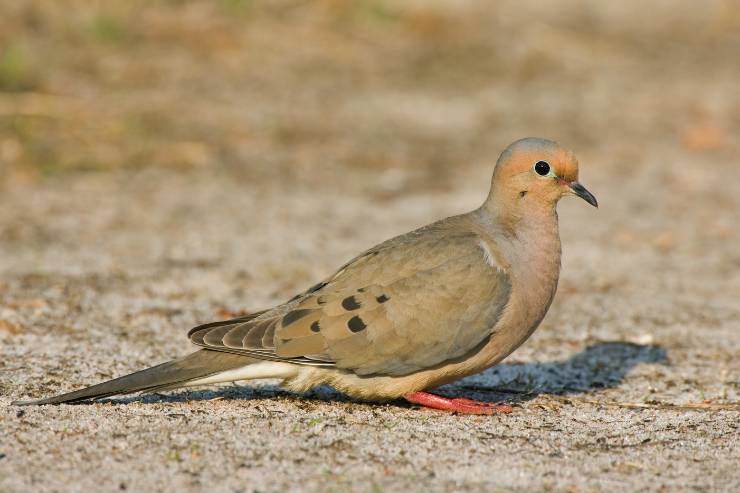
Size, Weight, and Wingspan of Mourning Dove:
- Size: 12 inches (31 cm)
- Weight: 4.0–6.0 ounces (112–170 g)
- Wingspan: 37–45 cm
Habitat: It is a migratory bird that flies in flocks during the daytime. This bird ranges from a wide variety of open and semi-open habitats. Such as grassland, lightly wooded areas, prairie, farms, and urban areas.
However, this bird avoids swamps and thick forests. Over the years, the mourning dove has been resident in southern Canada, the Greater Antilles, Socorro Island, and the Continental United States.
Feeding: The mourning dove eats seeds. Often, these birds are observed as they swallow grit-likes sand, gravel, etc. They rarely consume insects or snails.
It is recognized as one of the most attractive birds in Northern America that eats safflower, rapeseed, sunflower seeds, millet, and corn.
6. House Finch (Haemorhous mexicanus)
The house finch is a moderate-sized finch bird whose overall body possesses a long, square-tipped brown tail. The wing feathers are deep gray.
The coloration of both sexes varies due to seasonal changes. In most cases, it has been observed that adult males have reddish heads, necks, and shoulders that extend to the back and wings.
The coloration of male birds may also vary from red to pink. Likewise, female adults have brown upperparts and streaked underparts.

Size, Weight, and Wingspan of House Finch:
- Size: 5 to 6 inches (.5 to 15 cm)
- Weight: 9⁄16 to 15⁄16 oz (16 to 27 g)
- Wingspan: 8 to 10 inches (20 to 25 cm)
Habitat: This bird is a permanent resident of the southwestern United States, Mexico, and Southern Canada. It is found in semi-open areas such as backyards, farms, and forest edges.
Feeding: Primarily, these birds eat grains, seeds like nyjer seeds, sunflower seeds, and berries. Most often this bird forages on the ground.
7. Scarlet Ibis (Eudocimus ruber)
The scarlet ibis is a bird species of ibis that belongs to the family of Threskiornithidae. The bird coloration shows vivid pink to reddish pink plumages. It also has pink long-legged birds.
They have a long, narrow, decurved bill and their feet are also red. As they grow from young to mature birds, the coloration of scarlet begins to change.
This happens due to their heavy diet of red crustaceans. Sometimes, this bird is also called a red ibis. The wadering birds are prolific and are the national bird of Trinidad and Tobago.
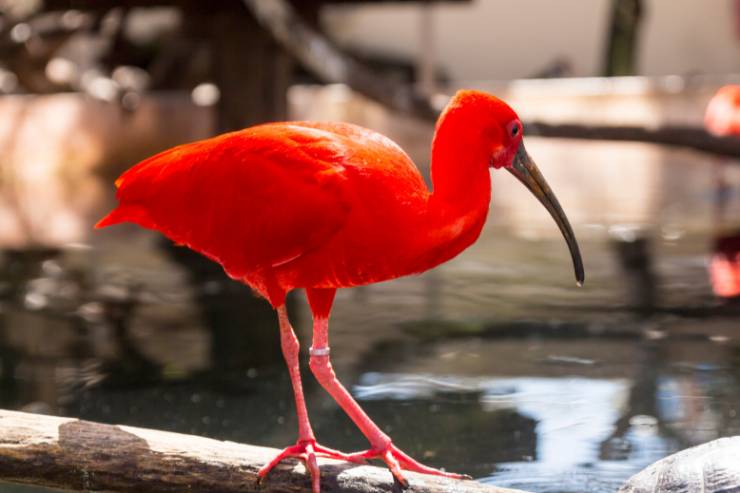
Size, Weight, and Wingspan of Scarlet Ibis:
- Size: 22–25 inches (55-63 cm)
- Weight: 3.1 lbs (1.4 kg)
- Wingspan: 21 inches (54 cm)
Habitat: These species of birds often gather in flocks in the wetlands, marshy habitats, shorelines, and rainforests. The distribution of this bird ranges from the vast areas of the Caribbean islands and South America.
In recent times, they are often seen in the coastal areas of Joinville and the Sao Francisco do Sul Islands. Besides this, they also exist in Venezuela, Brazil, Columbia, Guyana, and Suriname.
Feeding: It is a medium-sized wader that feeds on shrimp, scarabs, ground beetles, water bugs, water beetles, fish, and crustaceans. The scarlet ibis uses its long thin bill to forage the foods in soft mud or under plants.
Conclusion:
In conclusion, Florida, a state in the United States is a home that is filled with a wide variety of bird species. From the majestic Roseate Tern bird to the Scarlet Ibis, each of them has their charismatic presence.
Notably, pink birds are not the only avian residents that are found in Florida. If you are a bird enthusiast, then these captivating birds are often observed throughout Florida landscapes, wetlands, and coastal areas.






